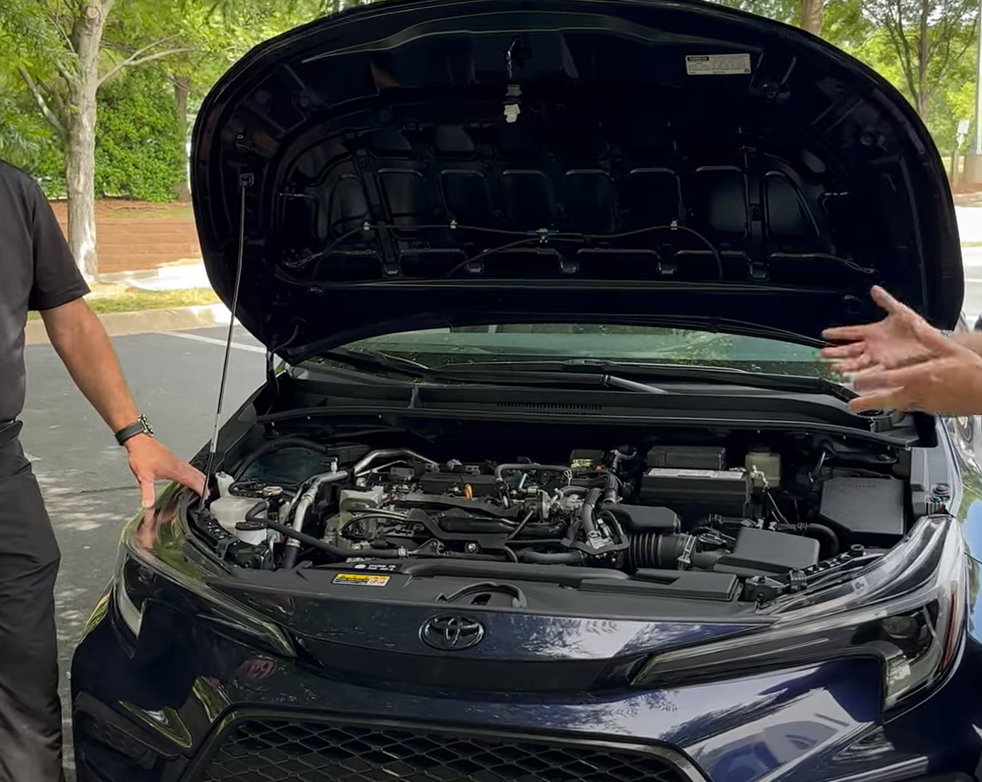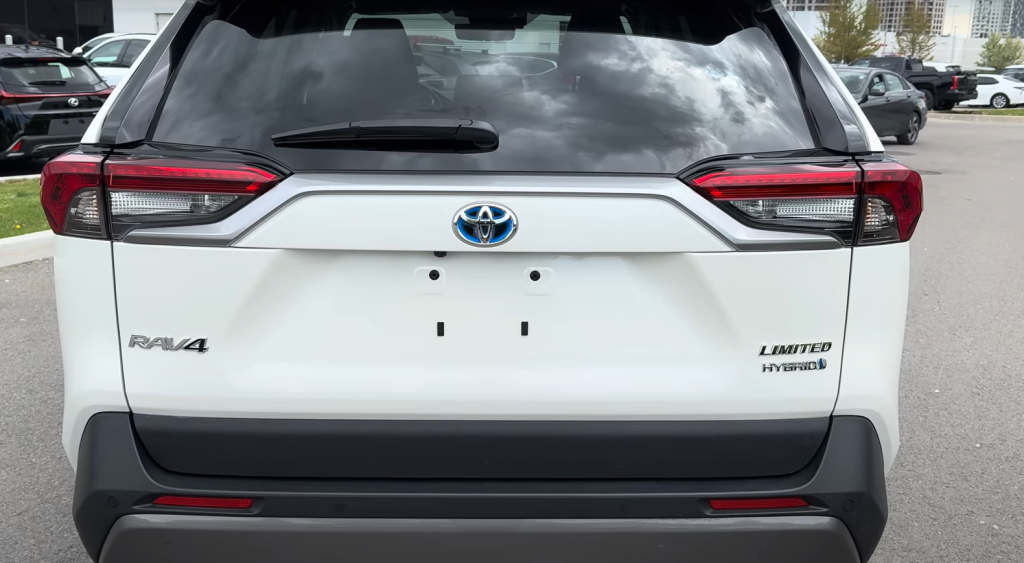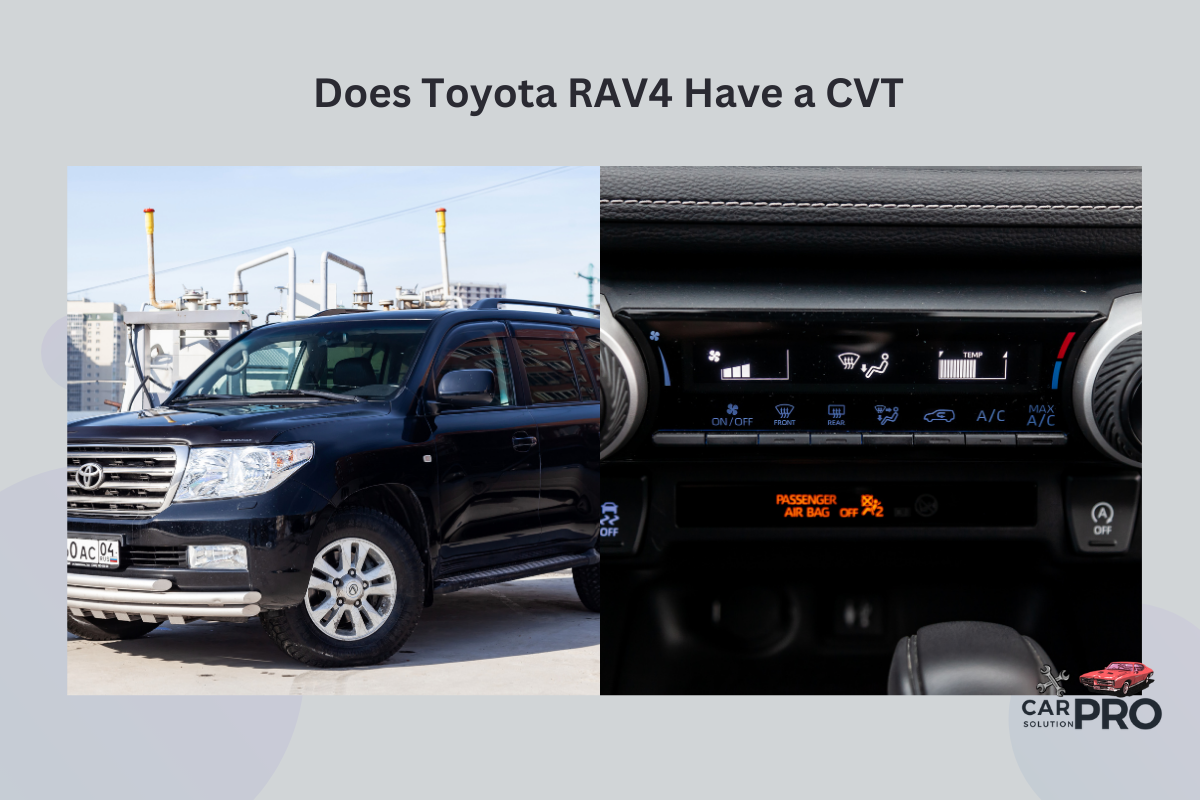Toyota RAV4 is a popular compact SUV known for its reliability and performance. Many car enthusiasts and potential buyers wonder about its transmission type. Some Toyota RAV4 models have a CVT (Continuously Variable Transmission), while others don’t.
The RAV4 lineup offers different transmission options depending on the specific model and trim level. RAV4 Hybrid and Prime models use an electronically controlled CVT (eCVT) with sequential shift mode. This transmission type provides smooth acceleration and improved fuel efficiency. On the other hand, gas-only RAV4 models come with a traditional automatic transmission.
Understanding the transmission type in a RAV4 is important for those considering purchasing one. It can affect the driving experience, fuel economy, and maintenance requirements. The choice between a CVT and a conventional automatic transmission often comes down to personal preference and specific driving needs.
Key Takeaways
- RAV4 Hybrid and Prime models feature eCVT technology
- Gas-only RAV4 variants use traditional automatic transmissions
- Transmission type affects driving experience and fuel efficiency
Overview of Toyota RAV4’s Transmission
The Toyota RAV4 has used different transmission types over the years. Most current RAV4 models come with an 8-speed automatic transmission.
For hybrid RAV4 models, Toyota uses an electronically controlled continuously variable transmission (eCVT). This system helps improve fuel efficiency.
Some key points about RAV4 transmissions:
- Standard models: 8-speed automatic
- Hybrid models: eCVT
- CVT: Not used in non-hybrid RAV4s
The eCVT in hybrid RAV4s is different from traditional belt-driven CVTs. It uses planetary gears and electric motors to create variable gear ratios.
Toyota’s choice of transmissions aims to balance performance and efficiency. The 8-speed automatic provides smooth shifting and good acceleration. The eCVT in hybrids maximizes fuel economy.
Transmission maintenance is important for RAV4 owners. Regular fluid changes and inspections can help ensure long-term reliability. Toyota recommends following the maintenance schedule in the owner’s manual.
Detailed Analysis of RAV4’s Transmission Types
The Toyota RAV4 has used different transmission types over the years. These include conventional automatics and more recently, CVTs in hybrid models. Let’s explore the evolution and technical details of RAV4 transmissions.
RAV4 Transmission Evolution
Early RAV4 models used standard automatic transmissions. The 2009 and 2010 RAV4s had well-regarded transmissions.
In recent years, Toyota introduced CVTs to some RAV4 models. The RAV4 Hybrid uses an eCVT system. This change improved fuel efficiency.
Non-hybrid RAV4s still use conventional automatics. The latest models have 8-speed automatic transmissions.
Toyota’s shift to CVTs in hybrids reflects industry trends toward more efficient powertrains.
Technical Specifications of RAV4 Transmissions
The RAV4 LE Hybrid, XLE Hybrid, XSE Hybrid, and Limited Hybrid all use CVTs. These transmissions offer smooth acceleration and better fuel economy.
Non-hybrid RAV4s use an 8-speed ECT-i (Electronically Controlled Transmission – intelligent) automatic. This transmission provides quick shifts and good fuel efficiency.
CVT RAV4s typically accelerate from 0 to 60 mph in about 10.5 seconds. This performance is comparable to models with conventional automatics.
RAV4 transmissions are designed for reliability. They require regular maintenance to ensure long-term performance.
Performance Implications of CVT in RAV4

The Toyota RAV4 does not actually use a traditional CVT. Instead, newer models feature a Direct Shift-CVT system. This transmission type aims to combine the benefits of both conventional and CVT transmissions.
Direct Shift-CVT provides smooth acceleration and improved fuel efficiency. It eliminates the “rubber band” feeling often associated with standard CVTs. This results in a more responsive driving experience.
The system allows for quick gear changes, enhancing the RAV4’s performance. It helps the vehicle maintain optimal engine speed across various driving conditions.
Fuel economy is a key advantage of this transmission. The Direct Shift-CVT helps the RAV4 achieve better gas mileage compared to traditional automatic transmissions.
Some drivers may notice reduced engine noise during acceleration. The CVT keeps the engine at its most efficient RPM, which can lead to a quieter ride.
While performance is generally good, towing capacity may be slightly lower with CVT-equipped models. This is something to consider for those who frequently tow heavy loads.
The Direct Shift-CVT also contributes to the RAV4’s improved handling. It provides seamless power delivery, which can enhance stability and control in various driving situations.
Comparison with Traditional Automatic Transmissions
The Toyota RAV4 offers different transmission options. These choices affect fuel efficiency and driving feel. Let’s explore how the CVT in some RAV4 models compares to traditional automatics.
RAV4 CVT vs. Automatic Transmission Efficiency
CVTs in RAV4 models aim for better fuel economy. They have no fixed gears, allowing the engine to run at its most efficient speed. This can lead to improved gas mileage compared to traditional automatics.
Traditional automatics in RAV4s have set gear ratios. They shift between these gears as needed. This can sometimes result in slightly lower fuel efficiency than CVTs.
CVTs are often found in RAV4 hybrid models. These use an electronic CVT (eCVT) system. The eCVT works with the hybrid powertrain to maximize efficiency.
Non-hybrid RAV4s typically use conventional automatic transmissions. These may have 6 to 8 gears, balancing performance and fuel economy.
Driving Experience with RAV4 CVT
CVTs in RAV4s provide a smooth, seamless acceleration. There are no distinct gear changes felt during driving. This can create a more relaxed driving experience, especially in city traffic.
Some drivers may notice a slight engine drone with CVTs. This happens because the engine can stay at one speed while the car accelerates. RAV4’s sound insulation helps minimize this effect.
Traditional automatics in RAV4s offer more familiar driving feel. Drivers can sense gear shifts, which some prefer. These transmissions may feel more responsive during quick acceleration.
RAV4s with regular automatics might perform better for towing. Their fixed gears can handle heavy loads more effectively than some CVTs.
Maintenance and Reliability of RAV4 CVT
The CVT in Toyota RAV4 models requires proper care to ensure longevity and smooth operation. Regular maintenance and addressing issues promptly can greatly impact its performance over time.
Common Issues and Longevity
Toyota’s CVT transmissions are known for their reliability. Many owners report driving their RAV4s for over 120,000 miles without major transmission problems.
The most common issues with RAV4 CVTs include:
- Fluid leaks
- Hesitation during acceleration
- Unusual noises
To prevent these problems, Toyota recommends changing the CVT fluid every 60,000 miles. This simple step can greatly extend the transmission’s life.
Some RAV4 models may experience early wear of belt and pulley systems. Regular inspections can catch these issues before they become serious.
Owner’s Perspective on RAV4 CVT Maintenance

RAV4 owners generally find CVT maintenance straightforward. Following Toyota’s recommended maintenance schedule is key to keeping the transmission in top shape.
Many drivers report smooth operation with regular fluid changes and inspections. Some tips from experienced owners include:
- Listen for unusual noises during acceleration
- Pay attention to any changes in shifting feel
- Address warning lights promptly
Most owners agree that preventive care is less costly than major repairs. Regular check-ups at a trusted mechanic can catch potential issues early.
Keeping detailed maintenance records can also help track the CVT’s health over time. This information is valuable for both current care and future resale value.
Frequently Asked Questions
Toyota RAV4 transmissions vary across model years and trim levels. Some use CVTs while others have conventional automatics. Let’s explore the key details about RAV4 transmissions.
What type of transmission does the Toyota RAV4 use?
Most Toyota RAV4 models use a conventional automatic transmission. Some hybrid versions have an eCVT (electronic continuously variable transmission).
The eCVT in hybrid models helps improve fuel efficiency and provides smooth power delivery.
Are there any known CVT transmission problems in the Toyota RAV4?
Toyota RAV4 models with CVTs have generally been reliable. No widespread issues have been reported.
Regular maintenance and proper driving habits can help prevent potential problems with the CVT.
Which model years of the Toyota RAV4 are equipped with a CVT?
RAV4 hybrid models, especially recent ones, use an eCVT system. This includes models from 2019 onwards.
Non-hybrid RAV4s typically use a traditional automatic transmission instead of a CVT.
How reliable is the CVT in the Toyota RAV4?
The eCVT used in RAV4 hybrids has proven to be reliable. Toyota’s reputation for quality extends to their transmissions.
Regular maintenance, including fluid changes, can help ensure the longevity of the eCVT.
Is the 2024 Toyota RAV4 equipped with a CVT transmission?
The 2024 Toyota RAV4 hybrid models continue to use an eCVT. Non-hybrid versions stick with a conventional automatic transmission.
Buyers can choose between these transmission options based on their preferences and needs.
What are the differences between the RAV4’s CVT and 8-speed automatic transmission?
The eCVT in hybrid RAV4s provides smooth, stepless power delivery and improved fuel efficiency. It uses a planetary gear set and electric motors.
The 8-speed automatic in non-hybrid models offers distinct gear shifts and may appeal to drivers who prefer a traditional feel.


